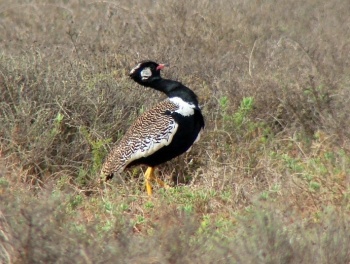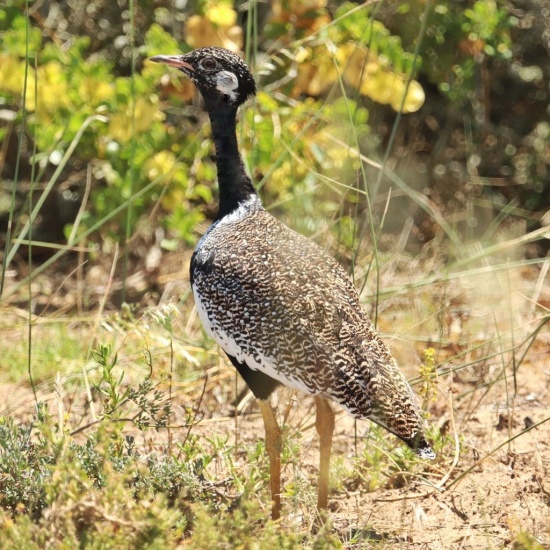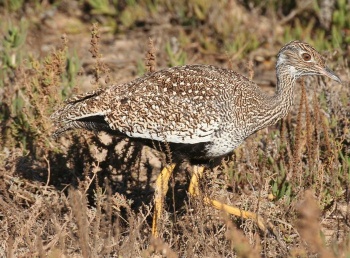(Picture of male added) |
(remove extra genus category) |
||
| (8 intermediate revisions by 5 users not shown) | |||
| Line 1: | Line 1: | ||
| + | [[Image:Southern Black Korhaan2.jpg|thumb|550px|right|Male <br />Photo © by {{user|the_kenyanbirder|Mustafa Adamjee}}<br />West Coast National Park, [[South Africa]], December 2019]] | ||
'''Alternative name: Southern Black Korhaan''' | '''Alternative name: Southern Black Korhaan''' | ||
| − | [[ | + | |
| − | + | ;[[Category:Afrotis]] [[:Category:Afrotis|Afrotis]] afra | |
| + | ''Eupodotis afra'' | ||
==Identification== | ==Identification== | ||
| − | Length 50-53 cm | + | Length 50-53 cm (19¾-20¾ in)<br /> |
| + | The eyes are brown, the bill is red with a grey tip, and the legs are yellow. | ||
| − | '''Adult male''': The head and neck are black, except for the white cheek patches, brown crown, and white edges to the crown. A white collar accross the mantle extends to the sides of the breast. The remainder of the underparts are black. The folded wings are barred black and brown (black bars broader than brown) and have broad white edges. In flight the primaries are black. | + | '''Adult male''': The head and neck are black, except for the white cheek patches, brown crown, and white edges to the crown. A white collar accross the mantle extends to the sides of the breast. The remainder of the underparts are black. The folded wings are barred black and brown (black bars broader than brown) and have broad white edges. |
| + | ====Flight==== | ||
| + | In flight the [[Topography#Wings|primaries]] are black. | ||
'''Adult female''': The head, neck and breast are brown, with black bars on the crown and neck; there is no white collar accross the mantle. Otherwise similar to the male. | '''Adult female''': The head, neck and breast are brown, with black bars on the crown and neck; there is no white collar accross the mantle. Otherwise similar to the male. | ||
| − | [[Image:FeBlackBustard_russkie_LangebaanWCape.jpg|thumb|350px|right|Female Black Bustard <br />Photo by {{user|russkie|russkie}} <br />Langebaan, Western Cape, [[South Africa]], January 2008]] | + | [[Image:FeBlackBustard_russkie_LangebaanWCape.jpg|thumb|350px|right|Female Black Bustard <br />Photo © by {{user|russkie|russkie}} <br />Langebaan, Western Cape, [[South Africa]], January 2008]] |
====Similar species==== | ====Similar species==== | ||
The closely related [[White-quilled Bustard]] has primaries that are predominantly white (obvious in flight), and the black and brown bars on the upper parts are similar in width. | The closely related [[White-quilled Bustard]] has primaries that are predominantly white (obvious in flight), and the black and brown bars on the upper parts are similar in width. | ||
| Line 14: | Line 19: | ||
Western and southern [[South Africa]]. A country endemic. | Western and southern [[South Africa]]. A country endemic. | ||
==Taxonomy== | ==Taxonomy== | ||
| − | + | This is a [[Dictionary_M-S#M|monotypic]] species<sup>[[#References|[3]]]</sup>. | |
| + | |||
*Formerly contained [[White-quilled Bustard]] (''E. afraoides''). Separated on the basis of differences in genetics, voice and plumage.<sup>[[#References|1]],[[#References|2]]</sup> | *Formerly contained [[White-quilled Bustard]] (''E. afraoides''). Separated on the basis of differences in genetics, voice and plumage.<sup>[[#References|1]],[[#References|2]]</sup> | ||
{{Afrotis vs. Eupodotis}} | {{Afrotis vs. Eupodotis}} | ||
==Habitat== | ==Habitat== | ||
| + | [[Image:Southern Black Korhaan male.JPG|thumb|350px|right|Male display<br />Photo © by {{user|Mark+Bruce|Mark Bruce}}<br />Addo Elephant National Park, Eastern Cape, [[South Africa]], November 2007]] | ||
Fynbos and Karoo scrub and shrublands. | Fynbos and Karoo scrub and shrublands. | ||
==Behaviour== | ==Behaviour== | ||
Usually solitary. Forages while walking; eats insects, reptiles, seeds and green shoots. | Usually solitary. Forages while walking; eats insects, reptiles, seeds and green shoots. | ||
====Breeding==== | ====Breeding==== | ||
| − | Polygynous and a solitary nester. One or two eggs are laid directly on the ground where the incubating female is concealed by the vegetation. The young are cared for by the female. | + | [[Dictionary_P-S#P|Polygynous]] and a solitary nester. One or two eggs are laid directly on the ground where the incubating female is concealed by the vegetation. The young are cared for by the female. |
====Vocalisation==== | ====Vocalisation==== | ||
A harsh ''krr-ack krr-ack'' by the male during displays. | A harsh ''krr-ack krr-ack'' by the male during displays. | ||
==References== | ==References== | ||
| − | # Crowe T.M., M.F. Essop, D.G. Allan, R.K. Brooke & J. Komen. 1994. "Overlooked units of comparative and conservation biology: a case study of a small African bustard, the Black Korhaan, Eupodotis afra." ''The Ibis''. (136) 166-75. | + | #Crowe T.M., M.F. Essop, D.G. Allan, R.K. Brooke & J. Komen. 1994. "Overlooked units of comparative and conservation biology: a case study of a small African bustard, the Black Korhaan, Eupodotis afra." ''The Ibis''. (136) 166-75. |
| − | # | + | #{{Ref-Hockeyetal05}}#{{Ref-Clements6thAug19}}#{{Ref-HM03Cor8}}#{{Ref-SibleyMonroe96}} |
{{ref}} | {{ref}} | ||
==External Links== | ==External Links== | ||
| − | {{GSearch| | + | {{GSearch|"Afrotis afra" {{!}} "Eupodotis afra" {{!}} "Black Bustard" {{!}} "Southern Black Korhaan"}} |
| − | [[Category:Birds | + | {{GS-checked}}1<br /><br /> |
| + | {{GS-checked}} | ||
| + | |||
| + | |||
| + | [[Category:Birds]] | ||
Latest revision as of 21:39, 17 December 2023
Alternative name: Southern Black Korhaan
- Afrotis afra
Eupodotis afra
Identification
Length 50-53 cm (19¾-20¾ in)
The eyes are brown, the bill is red with a grey tip, and the legs are yellow.
Adult male: The head and neck are black, except for the white cheek patches, brown crown, and white edges to the crown. A white collar accross the mantle extends to the sides of the breast. The remainder of the underparts are black. The folded wings are barred black and brown (black bars broader than brown) and have broad white edges.
Flight
In flight the primaries are black.
Adult female: The head, neck and breast are brown, with black bars on the crown and neck; there is no white collar accross the mantle. Otherwise similar to the male.
Similar species
The closely related White-quilled Bustard has primaries that are predominantly white (obvious in flight), and the black and brown bars on the upper parts are similar in width.
Distribution
Western and southern South Africa. A country endemic.
Taxonomy
This is a monotypic species[3].
- Formerly contained White-quilled Bustard (E. afraoides). Separated on the basis of differences in genetics, voice and plumage.1,2
Afrotis vs. Eupodotis
The species in genus Afrotis was formerly placed in genus Eupodotis by some authorities, however there now seems to be a consensus for using Afrotis.
Habitat

Photo © by Mark Bruce
Addo Elephant National Park, Eastern Cape, South Africa, November 2007
Fynbos and Karoo scrub and shrublands.
Behaviour
Usually solitary. Forages while walking; eats insects, reptiles, seeds and green shoots.
Breeding
Polygynous and a solitary nester. One or two eggs are laid directly on the ground where the incubating female is concealed by the vegetation. The young are cared for by the female.
Vocalisation
A harsh krr-ack krr-ack by the male during displays.
References
- Crowe T.M., M.F. Essop, D.G. Allan, R.K. Brooke & J. Komen. 1994. "Overlooked units of comparative and conservation biology: a case study of a small African bustard, the Black Korhaan, Eupodotis afra." The Ibis. (136) 166-75.
- Hockey, PAR, WRJ Dean, and PG Ryan, eds. 2005. Roberts' Birds of Southern Africa. 7th ed. Cape Town: John Voelcker Bird Book Fund. ISBN 978-0620340533
- Clements, J. F., T. S. Schulenberg, M. J. Iliff, S. M. Billerman, T. A. Fredericks, B. L. Sullivan, and C. L. Wood. 2019. The eBird/Clements Checklist of Birds of the World: v2019. Downloaded from http://www.birds.cornell.edu/clementschecklist/download/
- Dickinson, EC, ed. 2003. The Howard and Moore Complete Checklist of the Birds of the World. 3rd ed., with updates to October 2008 (Corrigenda 8). Princeton: Princeton Univ. Press. ISBN 978-0691117010
- Sibley, CG and BL Monroe. 1996. Birds of the World, on diskette, Windows version 2.0. Charles G. Sibley, Santa Rosa, CA, USA.
Recommended Citation
- BirdForum Opus contributors. (2024) Black Bustard. In: BirdForum, the forum for wild birds and birding. Retrieved 11 May 2024 from https://www.birdforum.net/opus/Black_Bustard
External Links
GSearch checked for 2020 platform.1
GSearch checked for 2020 platform.





